A spotting scope is a useful tool to have if astronomy is something that interests you. Spotting scopes are the best for observing astronomical objects because of their higher magnification. The best spotting scopes for astronomy are more portable, easier to hold, and a superior substitute for telescopes because they are easier to maintain stability with.
Finding the ideal model for astronomy might be a little difficult, though, because there are so many spotting scopes available. We can assist if your quest for the top astronomy spotting scopes has proven fruitless. Here is a list of the top astronomical spotting scopes currently on the market.
Whether you are observing celestial objects at home or while traveling, these sighting instruments will improve your views of them. Let’s look at it.
7 Best Spotting Scopes for Astronomy
1) Orion 80mm ED Semi-Apo Binocular Spotting Scope
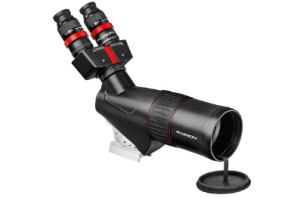
The Orion 80mm ED Semi-Opo Binocular Spotting Scope is another item on our list of the top spotting scopes for astronomy. For the best light collecting and bright image production, it has a sizable 80mm objective double lens. Additionally, it is constructed with high-quality optical glass that reduces chromatic aberration to provide images that are as clear and razor-sharp as possible.
The spotting sight is almost impervious to damage. It is constructed with premium components for maximum endurance. It is impact resistant for improved durability and waterproof for usage in any weather. Additionally, it has a built-in mounting bracket with 1/4″-20 threaded holes for simple tripod installation.
The spotting scope’s built-in binocular viewing design is another benefit. It may be rotated for convenient glassing. Additionally, it delivers a superb depth of field that is similar to 3D and lessens eye fatigue during extended periods of viewing. Furthermore, the scope has a 360-degree rotation collar that enables you to position the eyepieces at a position that is most comfortable for you.
Features
- Integrated mounting bracket
- Collar with 360-degree rotation
- Water-resistant design
- Incredibly low dispersion glass
- Extended eye relief
- Built-in binocular viewer
- Beam-splitting mirror with a dielectric coating
- 80mm aperture large
- Long-lasting design
- 500mm focal distance
2) Vortex Optics Razor HD Spotting Scopes
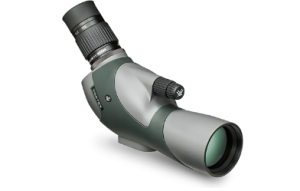
Optics is a field in which Vortex is a well-known and reputable brand. The Razor HD 27-6085 angled spotting scope is one of its high-quality optics products. One of the best spotting scopes available, the scope is constructed with cutting-edge optical technologies.
The scope offers bright and razor-sharp sight pictures in all lighting conditions thanks to its big 85mm aperture and completely multi-coated lenses. Advanced optical components that eliminate all aberrations for images with outstanding edge-to-edge clarity, resolution, and color accuracy are also incorporated.
The spotting scope’s tough housing is another feature that sets it apart. Because it is built of high-quality materials, you will use it for many years. Additionally, it has an Armortek coating that shields the external lenses from oil, dirt, and scratches as well as a rubber armor that protects it from shock and impacts.
The scope is also argon-purged and sealed with O-rings to make it waterproof and fog-proof. Additionally, it boasts a multi-position eyecup that twists up to provide long eye relief and a smooth helical focus for simple image focusing. And to top it all off, the spotting scope is lightweight for convenient travel.
Features
- Both water- and fog-resistant
- Adjustable eyecup
- Helix focus that is fluid
- Lens coating using Armortek
- Prism coating with several layers
- Extra-low dispersion glass with a high density
- Apochromatic triplet lens
- Extended eye relief
- Various viewing angles
3) Celestron C5 Spotting Scope, 52292, Black

One of the best spotting scopes available for astronomy is the Celestron C5. It has almost all the features you could possibly need for astronomy. Its user-friendly design makes it straightforward to use for both novice and experienced astronomers.
The scope is capable, with a high 50x magnification and a sizable 5″ aperture. Bright, detailed views are made possible by the big aperture design’s wide field of vision and great light-gathering capacity. Even better, the scope is compatible with a wide range of 1.25″ mount eyepieces for increased magnification. Additionally, it is small and light in weight for simple portability.
The spotting scope also includes Celestron’s exclusive StarBright XLT optical coatings, which maximize light transmission for the creation of vivid images. Additionally, it has a 6x30mm erect image finder scope that you can use to discover astronomical objects before looking at them via the big objective lens. That’s not all, either. With an angled eyepiece design that is perfect for digiscoping, this high-performing spotting scope attaches conveniently to any camera tripod. Overall, it’s a great spotting scope for nature and bird watching, in addition to astronomy.
Features
- Tiny and transportable
- Design for a 5″ Schmidt-Cassegrain telescope
- Erect picture diagonal at 45 degrees
- Erect picture finder scope 6x30mm
- Optical coatings StarBright XLT
- Appropriate for 1.25″ eyepieces
- Included are many accessories.
- Flexible mounting possibilities
- A large 5-inch opening
- Water-resistant design
4) Celestron 52268 C90 Mak Spotting Scope
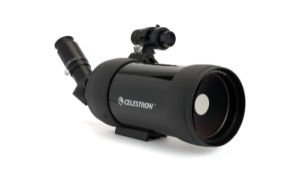
The Celestron C90 Mak Spotting Scope is your best option if you’re seeking the greatest astronomical spotting scope for the money. It provides a wealth of functions at an astonishingly low cost. Additionally, it is a versatile spotting scope that works well for astronomical and terrestrial applications.
The spotting scope has the well-known Maksutov-Cassegrain optical system, which offers high-power views without chromatic aberration. The optics also include superior multi-coatings that maximize light transmission for the creation of clear, brilliant images.
The scope’s big 90mm objective lens, which offers a wide viewing angle for quick object identification, is another asset. It has a 1.25-inch eyepiece adapter and an included 8x21mm erect image finder scope. You can use the scope’s high magnification of up to 100x with the 1.25-inch eyepiece to plainly view Jupiter, stars, the moon, and other celestial objects.
To top it all off, this optic has integrated T adapter threads for simple SLR camera installation and a small, light design for travel.
Features
- Erect picture finder scope 8x21mm
- T adapter threads built-in
- Set up an imaging system
- Optomechanical coatings
- The Maksutov-Cassegrain optical design
- Portable and small
- Universally compatible with 1.25″ eyepieces
- Fantastic high-power optics
- Includes a robust backpack case
5) Visionking 25-75×70 Maksutov Spotting Scope
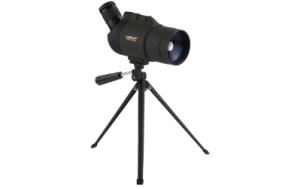
One of the greatest spotting scopes for astronomy for beginners is the Visionking 25-7570 Maksutov. It offers a wide range of luxurious and enjoyable features at a reasonable cost.
The scope’s powerful 25x to 75x magnification gives you ample strength to observe celestial objects clearly. A high-quality BaK-4 prism and a huge 70mm objective lens provide vivid, clear, and razor-sharp images, respectively. It also includes fully multi-coated glass lenses that offer the highest image brightness and resolution available.
The spotting scope’s all-weather design is another outstanding aspect. In order to deliver dependable waterproof and fog-proof performance, it is nitrogen filled and sealed with sturdy O-rings. Additionally, it offers a long eye relief that makes wearing glasses pleasant for all users, spectacles or not. The scope is lightweight and ergonomically designed for comfortable hauling in addition to everything else.
Features
- Both water- and fog-resistant
- optics with a full multi-coating
- Extended eye relief
- Lightweight and practical style
- 25x–75x large magnification
- High-end BaK-4 prisms
- Large-focal-length 70mm lens
6) Celestron – Ultima 100 Angled Spotting Scope
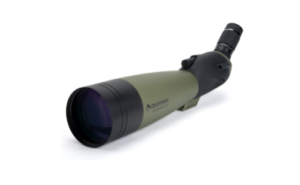
It is difficult to match the Celestron Ultima 100 Angled Spotting Scope in terms of versatility. This all-purpose scope can be used both on Earth and in space. Its simple layout and super-comfortable 45-degree viewing angle lessen neck and eye strain during prolonged glassing sessions.
The scope’s huge 100mm aperture offers a broad field of vision and excellent light-gathering capabilities. Anti-reflective coatings are applied multiple times to every lens surface to maximize light transmission for the creation of brilliant, clear images. The scope also includes an extended tripod mounting plate for comfortable viewing and a built-in T-adapter for digiscoping.
This angled spotting scope is constructed to be used in any kind of weather. It provides dependable all-weather performance and is waterproof and fog resistant. It has a tough, reinforced shell that offers dependable defense against hard outside handling. Additionally, it has a precise zoom eyepiece that enables you to focus for close-up views of far-off objects.
Features
- Oversized focus dials
- Fog- and fully waterproof
- A tough armored shell
- Optomechanical coatings
- High-quality zoom eyepiece with integrated T-adapter
- 100mm-wide objective lens
- A 45° viewing angle
- Design for a portable and robust refractor
7) Celestron 52238 C70 Mini Mak Spotting Scope, 25-75x
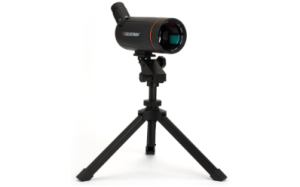
The Celestron C70 Mini Mak Spotting Scope is the next item on our list. It has a powerful enough wide 25x to 75x magnification to bring the heavenly things closer. Additionally, a variety of 1.25″ eyepieces can be used with the scope to get the necessary high magnification. This spotting scope is the lightest on our list, weighing just 3.21 ounces. It is tiny in size and light in weight for simple portability and usage.
It has a Maksutov-Cassegrain optical design, which offers chromatic aberration-free views of high-quality images, in terms of optical properties. The spotting scope also offers a broad field of vision, which is necessary for quickly locating various astronomical objects. The optics have several coatings to increase light transmission, especially in low light conditions, and to lessen light loss due to reflection. The scope is also quite adaptable and perfect for both terrestrial and celestial applications, which is the cherry on top.
Features
- The Maksutov-Cassegrain optical design
- 75x wide magnification
- Optomechanical coatings
- Small and light in weight
- Simple to use
- High portability and versatility
- Widely compatible with 1.25″ eyepieces
- Included are a tabletop tripod and a see-through enclosure.
Read Also:
7 Best Spotting Scope for 500 Yards
Best Budget Spotting Scope for Ocean Viewing
Best Spotting Scope for Wildlife Viewing
Best Bird Watching Spotting Scopes
7 Best Spotting Scopes for Long Range Shooting
Criteria for choosing the Best Spotting Scopes for Astronomy
Here are the main features you should look out for to help you make the best purchase, whether you’re purchasing your first spotting scope for astronomy or looking to upgrade.
Magnification
Magnification is yet another crucial aspect to take into account. The faraway heavenly objects are brought closer to your eyes with the use of magnification. High magnification power will give clearer views of far-off objects with spotting scopes for astronomy. Make sure that the spotting scope you choose has a large aperture in addition to a high magnification while you shop.
Weight
Weight is a crucial consideration when picking the best spotting scopes for astronomy. It is preferable to purchase a spotting scope with a lightweight construction if you want to observe the stars, moon, and other celestial objects while you are moving. In this manner, transporting it will be convenient for you.
Eye Comfort
The maximum distance between your eye and the spotting scope’s eyepiece is referred to as eye relief. If it is too short, it will be difficult for you to easily examine your stuff, especially if you wear glasses. To guarantee that wearing glasses is comfortable, be sure to choose a model with long eye relief.
Visual Design
Either catadioptric or refractor tubes are used in astronomy spotting scopes. While the latter has both mirrors and lenses within, the former only have lenses.
Catadioptric tubes’ internal mirrors enable a larger focal length while maintaining a lightweight and compact design. While most conventional spotting scopes are refractors, the majority of astronomical spotting scopes are catadioptric.
Benefits of Spotting Scopes for Astronomy
- Spotting scopes are lighter and more portable than other types of telescopes, making them easier to handle.
- Versatility. You may get a spotting scope that is perfect for astronomy as well as other outdoor activities including birding, wildlife viewing, tactical shooting, and more.
- Dual functionality A spotting scope can be used for astronomy at night and for seeing terrestrial objects during the day.
- Outstanding toughness. Spotting scopes are more resilient than astronomy telescopes since they are designed to be portable.
- Utilization simplicity. Spotting scopes are simpler to use than telescopes. They don’t need any sort of setup procedure.
Best Spotting Scopes for Astronomy FAQs
- Can you photograph the night sky with a spotting scope?
Yes. You can snap images of the celestial objects you see via your astronomy spotting scope by mounting a camera or a smartphone on it.
- Can you see the moon via a spotting scope?
Yes. You can view the moon plainly with a spotting scope with a wide magnification of at least 60x and a large aperture. If you have a high-quality spotting scope, you will also be able to view the stars, planets, and other celestial objects well.
- Spotting scopes—are they useful for astronomy?
Absolutely. Spotting scopes are useful astronomical instruments. For the majority of fundamental astronomy, they provide good adaptability and exceptional optical performance. They are easier to operate, more dependable, and portable.
Conclusion
Finally, choosing the best spotting scope for astronomy need not be a difficult or time-consuming process. Focus on finding a spotting scope that will serve your demands the best out of the many models on the market. It ought to be robust, useful, and adaptable. Purchase any spotting scope from the list we provided above, and be amazed at the vistas of the galaxy it will provide.

